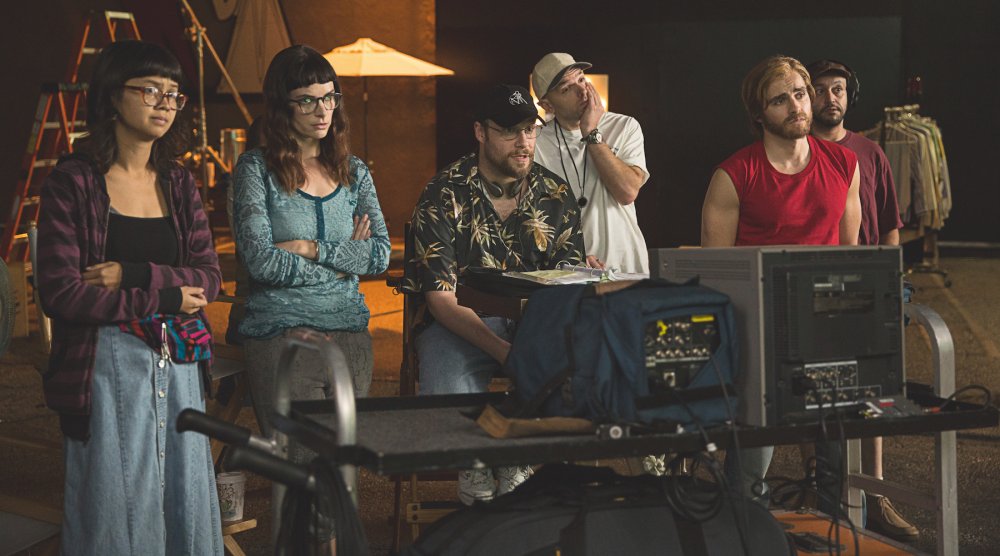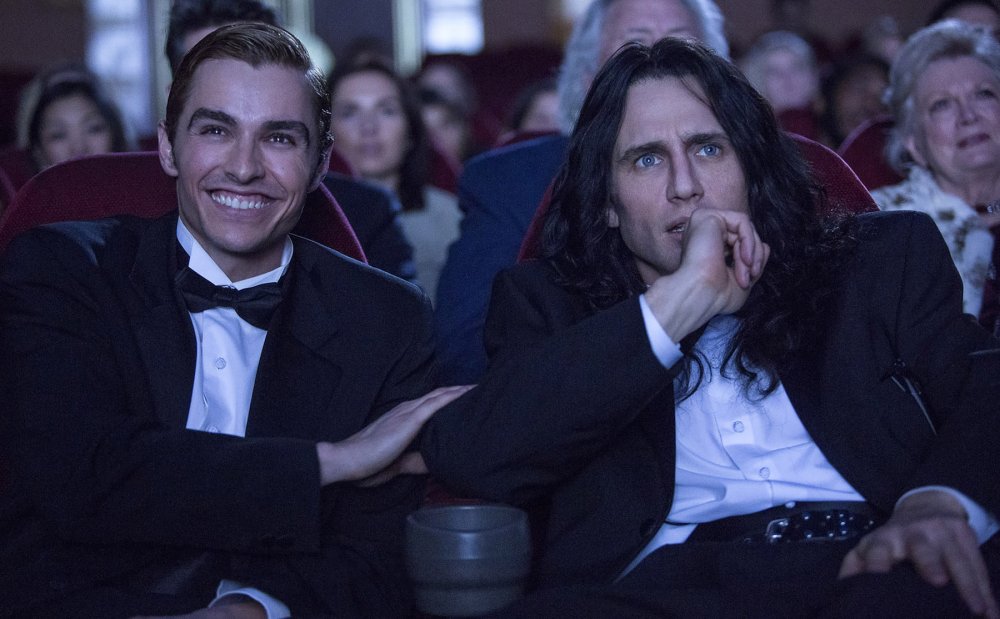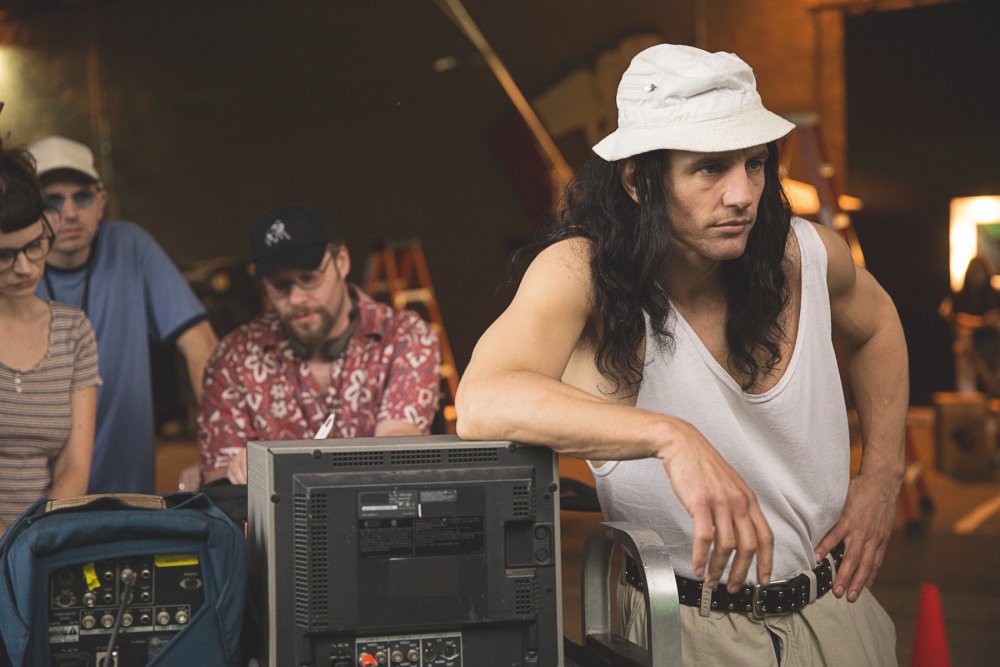“You’re tearing me apart!” In 1955, James Dean screamed this deathless line to electrifying effect in Rebel Without a Cause, giving voice to the frustrations of a generation. In 2003, Tommy Wiseau, oddball creator and star of legendary travesty The Room, screamed it again, provoking audience derision, a few thousand online memes and, ultimately, the transformation of his magnum opus from costly ($6 million) failure into lucrative midnight-movie phenomenon.
USA 2017
Certificate 15 103 mins approx
Director James Franco
Cast
Tommy Wiseau James Franco
Greg Sestero Dave Franco
Sandy Schklair Seth Rogen
Amber Alison Brie
Juliette Danielle Ari Graynor
Philip Haldiman Josh Hutcherson
Carolyn Minnott Jacki Weaver
Raphael Smadja Paul Scheer
Dan Janjigian Zac Efron
himself Bryan Cranston
Iris Burton Sharon Stone
Jean Shelton Melanie Griffith
Peter Jason Mantzoukas
UK release date 6 December 2017
Distributor Warner Bros UK
ohhitickets.co.uk
► Trailer
Erstwhile co-star and bosom buddy Greg Sestero recounted the film’s shambolic making and his curious friendship with Wiseau in a 2013 book, The Disaster Artist, the manifold absurdities of which have now been rendered on screen in hugely engaging fashion by James Franco and writers Scott Neustadter and Michael H. Weber. In what’s easily his most arresting work in front of the camera to date, Franco plays Wiseau, with his younger brother Dave as Sestero; theirs is a skewed, not-quite-Hollywood bromance, which the film follows over half a decade.
“You don’t want to be good, but great,” proclaimed Wiseau in his director’s statement for The Room. The Disaster Artist keenly latches on to the pathos inherent in Wiseau’s fervent belief that he was truly making great work, a classic for the ages – only recently has he claimed, unconvincingly, that the film was actually conceived as a black comedy. The Room bombed on its release, but Wiseau paid to keep it in prolonged circulation, infamously promoting it via a giant Los Angeles billboard featuring his lugubrious visage next to an RSVP telephone number. At the time of writing, the edifice has returned to Highland Avenue, with Franco’s face instead looming over the road.
After a prelude where celebrity talking heads are unanimous in their disbelief that The Room exists at all, we move to late 1990s San Francisco and a first meeting between Wiseau and Sestero, both attendees at an uninspiring acting workshop. Moved by Wiseau’s deranged reading of A Streetcar Named Desire, the 19-year-old Sestero befriends the considerably older man, whose exact origins and enormous independent wealth remain cloaked in mystery. Taken aback by his impulsive whims – an impromptu 300-mile pilgrimage to the site of James Dean’s fatal crash, a strident recitation of Shakespeare to the perplexed patrons of a diner – Sestero accompanies Wiseau to his pied-à-terre in LA, both men dreaming of their big Hollywood break.

But while Sestero secures an agent (a cherishable cameo from Sharon Stone), Wiseau’s hulking frame, eccentric demeanour and unplaceable accent prove limiting at auditions. In one excruciating encounter, he accosts a producer (Judd Apatow), who tells him starkly that never “in a million years” will he make it – “But after that?” croaks Wiseau with a straight face. “I wish we could just make our own movie,” laments Sestero. And thus The Room is born, a feature entirely funded out of Wiseau’s own pocket. He will direct and play the tortured lead, while Sestero – somewhat revealingly – is cast as the duplicitous best friend.
Of course, The Room only hobbled to completion in the first place thanks to Wiseau’s own money – it’s unlikely that anyone else would have seized on his script, a sub-Tennessee Williams farrago riddled with tin-eared dialogue, wild tonal lurches and narrative brick walls. The Disaster Artist recounts how Wiseau used his apparently bottomless pit of money to purchase, rather than rent, a whole suite of camera equipment – virtually unheard of in the industry. In exchange, the aghast facilities company offers its tiny backlot as studio space. With misplaced revolutionary spirit, Wiseau insists on shooting on film and digital simultaneously – “It’s just not done,” says a dumbfounded technician. The budget even extends to a director’s bathroom, erected in the middle of the set with just a flimsy curtain to preserve Wiseau’s modesty.

Uproariously ham-fisted scenes from the original that have since become well-worn YouTube staples are lovingly recreated, with Wiseau’s increasingly erratic behaviour – fluffed lines, inappropriate laughter, the insistence on close-ups of his backside (“I have to show my ass to sell the movie”) – exasperating a near-mutinous crew. Chief among them is Seth Rogen’s combative script supervisor Sandy Schklair, a seasoned pro slumming it on Wiseau’s set (Schklair claimed to have directed most of the film himself before walking off the production). The faintly homoerotic bond between Wiseau and Sestero, meanwhile – already significantly tested when Sestero moves in with girlfriend Amber (Alison Brie) – curdles ever more under the arc lights.
According to Sestero, Wiseau experienced an epiphany during a screening of The Talented Mr Ripley (1999), and came to fixate on that film’s elusive antihero while shooting The Room. Indeed, there is a hint of Ripley-esque social vampirism in the relationship between Wiseau and Sestero, a notion The Disaster Artist astutely plays up. While it’s suggested that Wiseau can be an embarrassment and liability for Sestero, even impacting on his career potential, the younger man remains happy to take his inexhaustible money and enable his narcissism. He’s also conscious that Wiseau’s inspiration for The Room’s histrionic betrayals comes from a deeply personal place, perhaps even mined from the implied envy, resentment and separation anxiety lurking around the edges of their friendship. Wiseau can be controlling, too: in a pivotal scene, his pig-headed intransigence leads Sestero to miss out on a promising television gig alongside Malcolm in the Middle-era Bryan Cranston (playing himself) – the part depends on Sestero maintaining his beard, which Wiseau demands he shave off for a risible ‘surprise’ in the film.
The Disaster Artist is the second project by Franco to excavate another film’s production, following 2013’s Interior. Leather Bar, which reimagined lost scenes from William Friedkin’s Cruising (1980). There’s something intriguing in Franco, a frequent and prolific multihyphenate on disparate work ranging from wacky comedy (2005’s The Ape) to ambitious adaptations of William Faulkner (As I Lay Dying, 2013) and Cormac McCarthy (Child of God, 2013), directing himself just as Wiseau did; the meta aspects are intensified even more when you learn that Franco reportedly directed the film in character.

As the misbegotten auteur, he pulls off a sensational physical performance, meticulously capturing Wiseau’s bizarre mannerisms and peculiar vocal rhythms, without descending into lazy mimicry. If Franco occasionally sails close to the broad goofiness familiar from his prior collaborations with Rogen, he also acutely expresses the character’s essential otherness and oddly poignant levels of self-delusion – it’s a fastidious portrait of a man who seems terminally oblivious to how off-putting he can be.
At the opposite end of the showy spectrum, the younger Franco is affable company as the clean-cut straight man to his sibling’s moody Svengali, persuasively conveying Sestero’s arc from impressionable young pup to enervated handler of his friend’s mania. Meanwhile it’s amusing to see Jacki Weaver and other screen stalwarts cast as no-name actors whose brief CVs suggest that the experience of making The Room may have put them off the craft for good.
Remarkable films have sometimes risen from the ashes of defeat – consider Lost in La Mancha (2001), a brilliant documentary forged from Terry Gilliam’s Don Quixote debacle, or David Lynch’s Mulholland Dr. (2001), a masterwork salvaged from a dumped TV series. While The Room is unlikely to be reappraised any time soon, its afterlife as raucous roadshow ritual denotes some kind of victory, albeit surely a pyrrhic one, for Wiseau. In this sense, both The Room and The Disaster Artist prove exceptions to the old adage that you can’t polish a turd: while Wiseau saw his ‘disasterpiece’ evolve beyond his imagining, Franco, for his part, has spun tragicomic gold from the most tragic of base materials.
-
Sight & Sound: the January 2018 issue

The best films of 2017 and reflections on the year in cinema, plus Get Out, Twin Peaks: The Return, Frances McDormand, Gary Oldman, Miike Takashi,...
-
The Digital Edition and Archive quick link
Log in here to your digital edition and archive subscription, take a look at the packages on offer and buy a subscription.










